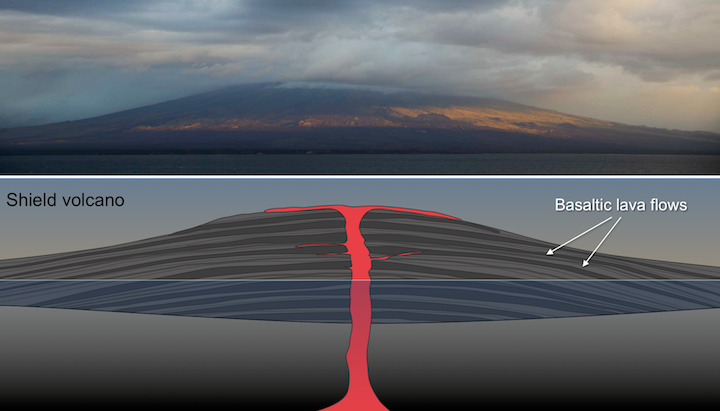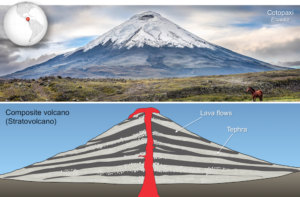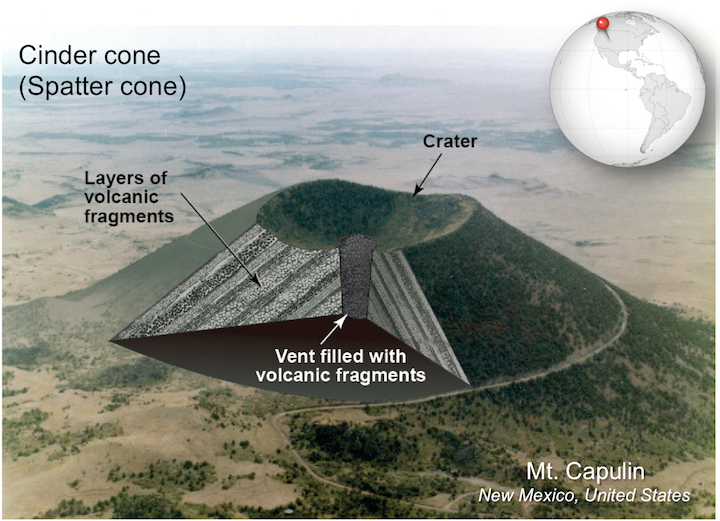11.3 Types of Volcanoes
The products of volcanism that build volcanoes and leave lasting marks on the landscape include lava flows that vary in viscosity and gas content. They also include tephra ranging in size from less than a mm to blocks with masses of many tonnes. Individual volcanoes vary in the volcanic materials they produce, and this affects the size, shape, and structure of the volcano.
There are three types of volcanoes: cinder cones (also called spatter cones), composite volcanoes (also called stratovolcanoes), and shield volcanoes. Figure 11.22 illustrates the size and shape differences amongst these volcanoes.
Shield volcanoes, which get their name from their broad rounded shape, are the largest. Figure 11.22 shows the largest of all shield volcanoes—in fact, the largest of all volcanoes on Earth—Mauna Loa, which makes up a substantial part of the Island of Hawai‘i and has a diameter of nearly 200 km. The summit of Mauna Loa is presently 4,169 m above sea level, but this represents only a small part of the volcano. It rises up from the ocean floor at a depth of approximately 5,000 m. Furthermore, the great mass of the volcano has caused it to sag downward into the mantle by an additional 8,000 m. In total, Mauna Loa is a 17,170 m thick accumulation of rock.

Kīlauea Volcano is also a shield volcano, albeit a much flatter one. Kīlauea Volcano rises only 18 m about the surrounding terrain, and is almost not visible in the scale of the diagram, however it still stretches over a distance of 125 km along the eastern side of the Island of Hawai‘i.
Composite volcanoes are the next largest. Mt. St. Helens is shown on the left of Figure 11.22. It rises 1,356 m above the surrounding terrain in the Cascade Range of the western United States, and has a diameter of approximately 6 km. Composite volcanoes tend to be no more than 10 km in diameter. Unlike shield volcanoes, composite volcanoes have a distinctly conical shape, with sides that steepen toward the summit.
Cinder cones are the smallest, and almost too small to see next to a volcano like Mauna Loa. Eve Cone is a cinder cone on the flanks of Mt. Edziza in northwestern British Columbia. It rises 172 m above the landscape, and has a diameter of under 500 m. Cinder cones have straight sides, unlike upward-steepening composite volcanoes, or rounded shield volcanoes.
Volcano Structure
Shield Volcanoes
Shield volcanoes, like the Sierra Negra volcano in the Galápagos Islands (Figure 11.23, top), get their gentle hill-like shape because they are built of successive flows of low-viscosity basaltic lava (Figure 11.23, bottom). The low viscosity of the lava means that it can flow for long distances, resulting in the greater size of shield volcanoes compared to composite volcanoes or cinder cones.

Composite Volcanoes (Stratovolcanoes)
Composite volcanoes, like Cotopaxi in Figure 11.24 (top), consist of layers of lava alternating with layers of tephra (blocks, bombs, lapilli, and ash; Figure 11.24, bottom). The layers (strata) is where the alternative name, stratovolcano comes from. Cotopaxi displays the characteristic shape of composite volcanoes, which have slopes that get steeper near the top of the volcano. The change in the slope reflects the accumulation of tephra fragments near the volcano’s vent. Composite volcanoes typically erupt higher viscosity andesitic and rhyolitic lavas, which do not travel as far from the vent as basaltic lavas do. This results in volcanoes of smaller diameter than shield volcanoes. A notable exception is Mt. Fuji in Japan, which erupts basaltic lava.

From a geological perspective, composite volcanoes tend to form relatively quickly and do not last very long. If volcanic activity ceases, it might erode away within a few tens of thousands of years. This is largely because of the presence of pyroclastic eruptive material, which is not strong.
Cinder Cones (Spatter Cones)
Cinder cones, like Mt. Capulin in Figure 11.25, have straight sides and are typically less than 200 m high. Most are made up of fragments of scoria (vesicular rock from basaltic lava) that were expelled from the volcano as gas-rich magma erupted. Because cinder cones are made up almost exclusively of loose fragments, they have very little strength. They can be eroded away easily, and relatively quickly.

References
Rubin, K. (n.d.) Mauna Loa Volcano. Retrieved 23 August 2017. Visit website

